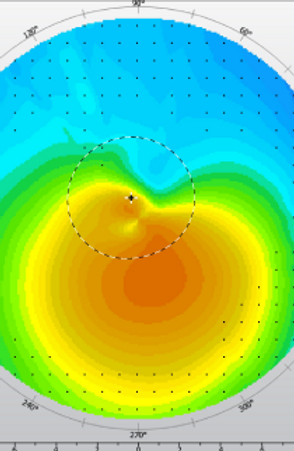Eye Diseases
The CDC reports that vision loss due to eye disease is listed as one of the top ten causes for disability among American adults. Our mission at Clarity Eye Care is to prevent and treat eye disease to keep every one of our patients seeing and feeling their best.

Diabetic Retinopathy
Diabetic retinopathy is a disease affecting the retina, a part of the inside of the eye that detects light. In long-term or uncontrolled diabetes, the blood vessels throughout the body begin to leak. This leakage in the eye can cause swelling and even blindness. It is important for all patients with diabetes to have a retinal exam once per year. At Clarity Eye Care, most patients take advantage of a dilation-free diabetic exam with our Optomap Retinal Imaging. This enables us to fully examine the retina without dilating eye drops, saving you time and hassle. Dr. Armitage then reviews these images with you during your exam and writes a letter to your primary care doctor.

Dry Eye Disease/Meibomian Gland Dysfunction
Clarity Eye Care has made itself a leading expert in dry eye diagnosis and treatment in the Omaha area. Our advanced Oculus Keratograph provides imaging of their Meibomian glands, which produce the protective oil layer of the tears. Dr. Armitage reviews these images with patients to track for early changes that can become ocular surface disease later on.
Our office is equipped with LipiFlow, a state-of-the-art treatment system that improves both the signs and symptoms of Meibomian Gland Dysfunction.

Keratoconus
Keratoconus is a disease affecting the cornea, the very front structure of the eye. Over time, it causes the cornea to become misshapen and thinned so that it bulges out toward the bottom. This causes poor vision in even the best glasses prescription. In severe cases of keratoconus, the patient may need to have a corneal transplant.
Clarity Eye Care is equipped with a corneal topographer which helps diagnose keratoconus. Keratoconus is most easily treated if caught early, which makes annual exams very important.
Dr. Laura Armitage specializes in custom contact lenses made for people with keratoconus or other similar corneal disorders. Oftentimes these lenses are considered medically necessary and may be covered by vision insurance.

Cataracts
Cataracts are one of the most common eye disorders in patients over the age of 50. A cataract is clouding over of the crystalline lens that is inside the eye. This is a natural age-related process in most cases. Cataracts cause the vision to become foggy or blurry, and they also cause severe halos and glare around lights at night.
Our doctors examine for cataracts at each comprehensive eye exam and track their progress so that patients can have them treated as soon as is necessary. We work closely with excellent cataract surgeons to ensure the best comfort and vision for our patients during and after cataract surgery.

Glaucoma
Glaucoma is a potentially devastating disease affecting the optic nerve, the part of the eye that takes visual information to the brain. Glaucoma often results from high pressure inside the eye, but can also happen when the eye pressure is normal. If caught early, Glaucoma can be treated to prevent vision loss. However, if Glaucoma is not detected and treated early enough, it is often too late to prevent permanent loss of vision.
At Clarity Eye Care, we test for Glaucoma using multiple methods at every comprehensive eye exam. We also have a Cirrus OCT, a specialized machine that helps to image the optic nerve to help with diagnosis and tracking of Glaucoma.

Macular Degeneration
Age-Related Macular Degeneration (AMD) is one of the leading causes of blindness in the United States. It is caused by small buildups of waste material forming in the layers of the macula (the central part of the retina). These buildups, called drusen, distort vision and can cause permanent loss of the central part of the vision. In severe ('wet') AMD, extra blood vessels can grow behind the macula, causing severe vision damage.
At Clarity Eye Care, we use our Cirrus OCT imaging system to help catch AMD at its very earliest stages. Our doctors are experts in not just early diagnosis of AMD, but recommending things that can be done to lower your risk factors for AMD. In severe cases, we partner with excellent ophthalmologists to coordinate treatment.

